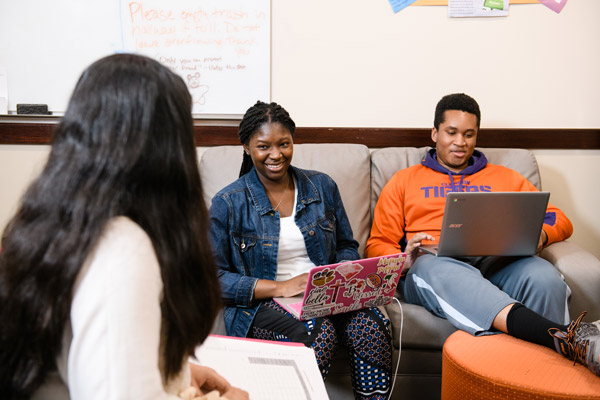- OTEI Home
- Clemson Resources
- Request OTEI Services
- Events and Programs
- Teaching Guides
Building Rapport

What is Rapport?
Functional classrooms are fueled by communication, respect and understanding. Hold to these three values and you'll enhance classroom learning in-person and online, ultimately developing a rapport with your students. But what exactly is rapport? Rapport is equal parts social-psychology and emotional connection. By building professional relationships in the classroom and meeting students where they are, you can construct meaningful pathways for learning and advance your effectiveness as an academic instructor.
Six Aspects of Rapport
When it comes to developing a rapport with students, what are your primary focuses and goals? Studies show that it's important to maintain a healthy balance of these six foundational aspects:
-
Building student engagement
-
Presenting self as an available resource for students
-
Holding students accountable
-
Being fair in assessments and daily treatment
-
Interacting professionally
-
Showing empathy and relationship
Research-Based Suggestions
To further build rapport and increase student learning, consider the following:
- Use student names regularly; this habit has a highly positive impact on student learning
- Track your interactions with students to ensure that you regularly address each student (either one-on-one or in class interaction)
- Walk around—physical presence is powerful and builds community
- Note that all of these methods (besides walking around) can be used online as well
- Encourage conversation through short questions; "What's the first step? What is your question?"
- Encourage elaboration on what they say with open-ended prompts; "What are your thoughts?"
- Recognize and thank students for contributions to class
- Ask students for feedback. Creating a feedback loop is an important, evidence-based teaching technique that can improve student learning significantly. Asking for feedback from students leads to a stronger gain in learning than giving feedback.
Visit our Teaching Guides to learn more about what the Office of Teaching Effectiveness and Innovation (OTEI) can do for you.
-
References
Benassi, V., Overson, C. E., & Hakala, C. M. (2014b). Applying the Science of Learning in Education: Infusing Psychological Science into the Curriculum. (C. M. Benassi, V. A. Overson, C. E. Hakala, Ed.) American Psychological Association (Vol. 37). Retrieved from the Society for the Teaching of Psychology web site. doi:10.1111/napa.1201. www.scholars.unh.edu/cgi
National Research Council. 2000. How People Learn: Brain, Mind, Experience, and School: Expanded Edition. Washington, DC: The National Academies Press. https://doi.org/10.17226/9853. www.nap.edu/catalog
-
Resources
Maryellen Weimer. (2017) Building Rapport: Moving Beyond Teacher Characteristics to Actions that Promote Learning. Faculty Focus Blog. www.facultyfocus.com/articles
Maryellen Weimer. (2017). The Importance of Learning Students’ Names, Faculty Focus Blog. www.facultyfocus.com/tag
Jason Barr (2016). Developing a Positive Classroom Climate. IDEA Paper #61. www.ideaedu.org/Portals
Marilla Svinicki (2016). Motivation: An Updated Analysis. IDEA Paper #59. www.ideaedu.org/Portals

